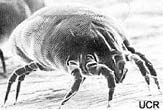Deadly Ecosystem ... In Your Pillow

Your favorite pillow holds an entire ecosystem of disgusting bugs and potentially deadly fungi, a new study suggests.
The typical pillow contains more than a million fungal spores, researchers found. That's several thousand spores for every little gram of material.
There's more.
Other studies have shown pillows and other bedding harbor dust mites, microscopic spider-like creatures that feed on flakes of human skin (see picture at top of page).
"We know that pillows are inhabited by the house dust mite which eats fungi, and one theory is that the fungi are in turn using the house dust mites' feces as a major source of nitrogen and nutrition (along with human skin scales)," says study leader Ashley Woodcock at the University of Manchester. "There could therefore be a 'miniature ecosystem' at work inside our pillows."
All pillows
Woodcock and her colleagues examined feather and synthetic pillows that had been in use from 1.5 years to 20 years.
Sign up for the Live Science daily newsletter now
Get the world’s most fascinating discoveries delivered straight to your inbox.
The most common fungi found is called aspergillus fumigatus, which is also the most likely to cause disease, the researchers say. It is in fact the leading infectious cause of death in leukemia and bone marrow transplant patients.
Fungi also exacerbate asthma.
Synthetic pillows carried more fungi, the study concluded. Other species uncovered include fungi normally found in bread and in showers.
The results are detailed today in the journal Allergy. The study is not the first to point out the problem.
Research in 2000 by the National Institute of Environmental Health Sciences (NIEHS) concluded that 22 million U.S. homes had bedding with dust mite allergen concentrations exceeding a level thought to trigger asthma symptoms.
What to do
Hospitals typically cover pillows in plastic. But when patients go home, often with weakened immune systems, their own pillows may pose a risk of infection, the scientists said.
"These new findings are potentially of major significance to people with allergic diseases of the lungs and damaged immune systems - especially those being sent home from hospital," said Geoffrey Scott, Chairman of the Fungal Research Trust which funded the study.
You can take action. The NIEHS suggests:
- Put allergen-impermeable covers on pillows and mattresses.
- Wash bedding at least weekly in hot water.
- Vacuum carpets regularly and steam clean periodically.
If all this doesn't disgust you, consider one final thought: In a separate study this year, scientists found evidence that aspergillus fumigatus is having sex, an act thought not possible among fungi.
- Dandruff Found in the Air
- Americans Don't Wash Their Hands
- Deadly Bugs Survive for Weeks in Hospitals
- Rise of Deadly Superbug
Robert is an independent health and science journalist and writer based in Phoenix, Arizona. He is a former editor-in-chief of Live Science with over 20 years of experience as a reporter and editor. He has worked on websites such as Space.com and Tom's Guide, and is a contributor on Medium, covering how we age and how to optimize the mind and body through time. He has a journalism degree from Humboldt State University in California.
Most Popular



